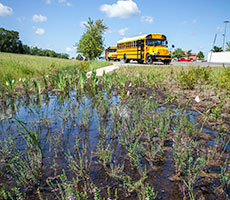Naturally beautiful stormwater management
Bioswales将雨水径流引入地下,以减少到达下水道系统的水量。一旦植物生长起来,生物沼泽几乎不需要维护。这种高效的设计比典型的草坪草更省力、燃料、空气污染和碳排放。
 Landscape irrigation consumes nearly one-third of all residential water use in the U.S., totaling more than 7 billion gallons per day. As much as half of that water is wasted due to evaporation and runoff caused by inefficient irrigation systems. CLC’s bioswales on this campus survive with only the rainwater that falls on the site; no potable water is required.
Landscape irrigation consumes nearly one-third of all residential water use in the U.S., totaling more than 7 billion gallons per day. As much as half of that water is wasted due to evaporation and runoff caused by inefficient irrigation systems. CLC’s bioswales on this campus survive with only the rainwater that falls on the site; no potable water is required.
The plants in this bioswale include blue flag iris, dense blazing star, swamp milkweed and awl fruited sedge. These plants are better able to tolerate the salt runoff from the parking lots in the winter.
Additional stormwater management features along the Living Lab Trail include the prairie, wetlands and Willow Lake. Look for other bioswales throughout the parking areas on campus.
Benefits of Bioswales
At the College
我们在许多方面节约用水。将我们的割草机设置为4英寸,可以减少灌溉草坪区域的需要,并允许草在干旱期间保持更长时间的绿色。我们通过LEED认证的设施中的卫生间配备了低流量装置和厕所,并回收雨水,进一步减少了对淡水的需求。
 In the Community
In the Community
Consumers can have a big impact on reducing the volume of fresh water wasted at home. Fixtures rated by the U.S. EPA’s WaterSense program such as faucets, shower heads and toilets reduce water consumption while still maintaining an effective flow rate. Connecting a timer to your hose can reduce overwatering your lawn or garden.
Around the World
Studies by the United Nations predict the worldwide demand for fresh water will outstrip water supply significantly by 2030. Even water-rich areas like Lake County would be impacted. Visit our website to learn how people are working to preserve water sources world-wide.